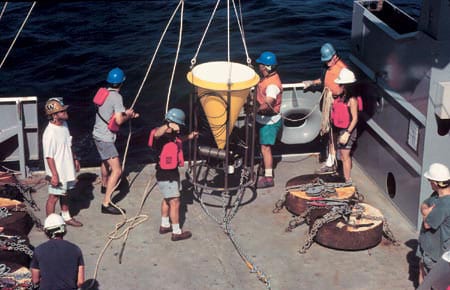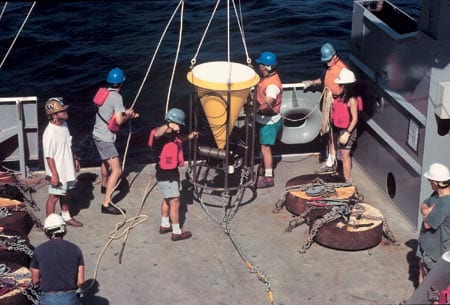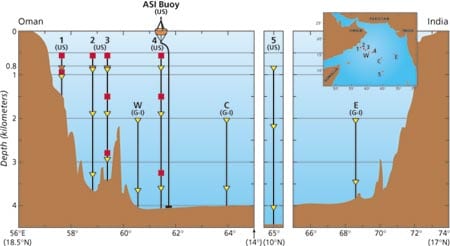
Deploying the Rain Catchers
Deployment of a deep-ocean sediment trap mooring begins with the ship heading slowly into the wind.
October 1997 —Deployment of a deep-ocean sediment trap mooring begins with the ship heading slowly into the wind. The mooring line, with the various instruments attached in top-to-bottom order, is paid out over the stern from a winch and pulled away from the ship, straight behind, seemingly almost on its own power. First over the stern is the top of the mooring, whose radio beacon and flashing light are designed to operate only when they are on the surface. Next comes a cluster of 20 floats, each capable of supporting 50 to 60 pounds in water, to provide upper-mooring buoyancy. These floats are all made of thick, plastic-covered glass spheres designed to withstand the great pressure of the deep ocean.
Next on the mooring line comes the shallowest sediment trap. Additional instruments such as a current meter are often deployed with the trap. This float/trap sequence is repeated until the end of the mooring line is reached and all the instruments are laid out along the surface. An acoustic release is connected near the end of the mooring. This critical device will be commanded to release the mooring from the anchor, allowing it to return to the surface at the end of the collection period.
Lastly, an anchor, usually about a ton of used freight car wheels, is connected to the lower end of the release with a long, highly flexible nylon line that stretches to absorb the landing impact. While a team of technicians and deck personnel are engaged in the laying out process, the bridge maneuvers the ship to the designated mooring location, passing a certain distance beyond where the anchor is to be set. When ready, the anchor is dropped into the ocean with a sizable splash. As the anchor sinks, the mooring line is pulled into the water, and one by one the traps and other equipment disappear from the surface. Finally, the radio signal goes silent as it slips beneath the waves. Resistance from the mooring pulls the anchor back a certain distance that we have allowed for from our modeling. The moment the anchor arrives on the ocean floor, its precise location can be calculated through acoustic communication from the ship to the release.
When the deployment period is over, usually a year, a ship will again be exactly positioned over the mooring, using satellite navigation. Technicians “talk” with the acoustic release near the anchor with a transducer—a microphone for communicating through the water column—and tell it to free the mooring from the anchor. In a short time, the bright orange floats at the summit of the mooring appear on the surface and the radio beeps. The rest of the recovery protocol reverses the deployment procedure. Traps and floats are picked up one by one and the mooring wire is wound on the winch. Finally, the acoustic release is recovered and the mooring crew can take a break—until it’s time to redeploy the moorings.
Slideshow

Slideshow
- Working aboard R/V Thomas Thompson (University of Washington), Steve Manganini (black shirt) manages the launch of one of the sediment trap moorings shown in the illustration below.
- The array extended over 1,850 kilometers between Oman and India with the various traps synchronized to open and close simultaneously.

